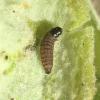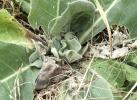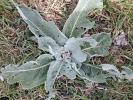35.015 Nothris verbascella (Hübner, 1813)
Status and Distribution
Formerly found at two locations in Norfolk and one in Suffolk and, until 2024, the last British record was from West Norfolk in 1971. Searches from the late 1980s onwards, where the foodplant is still present, had failed to relocate the moth and it is was subsequently considered extinct in the British Isles. A record from Monk Haven, Pembrokeshire has not been possible to confirm and is thought to have been entered in error but the food-plant does occur in that county as an introduced species.
On 2nd September 2024, a single moth came to an MV light in Norfolk (D. Jones) and subsequent searches for larvae in the area have produced a few sites with feeding signs on Hoary Mullein. A further five adults were located amongst the plants at one of these sites. The location is in the Norwich area and further searches in Spring 2025 produced larvae at two sites.
%201c_1.jpg)
Provisional map
Pupa
Foodplant and Larval Feeding Signs
Verbascum pulverulentum (hoary mullein), see plant distribution map. In Europe reported from Verbascum densiflorum (dense-flowered mullein), V. phlomoides (orange mullein) and V. thapsus (great mullein).
Pre-1972 in Britain, the larvae could be found throughout the year, initially gregariously on undeveloped leaves in the centre of the plant. In the spring newly emerged larvae were found feeding on younger leaves or boring into stalks or stems, while the over-wintered larvae fed under the larger lower leaves in a silken web. The September 2024 reports included obvious feeding signs, a few pupae, and adults resting on the foodplant.
In Spring 2025 Dave Jones reported checking apparent feeding signs at the main site with 16 larvae located. One of the other sites from 2024 was also checked and amongst c14 plants, several had apparent feeding signs with one larva found. In all but one case he only found one larva per plant although he advises it's possible there were more hidden. The exception was one plant which was large and relatively isolated which had at least 3 larvae. The larvae were usually found in a 'mess' of material often formed into a protective 'cocoon' on the underside of a leaf or more often in the heart of the rosette - often this was littered with frass. In many cases there were numerous patches where a larva had evidently fed leaving behind a vacated 'cocoon'. Once exposed the larva usually moved surprisingly quickly often burrowing deeper into the heart of the rosette. Most of the larvae were approximately 1cm but on the plant with three, each was a different size with one being very small.
Habitat
Finding the Moth
Searches of sites where the foodplant still occurs in any abundance would be worthwhile at any time of year for the larvae or their feeding signs.
Similar Species
A distinctive pale buff moth with a single prominent black spot on the forewing at two-thirds. Not likely to be confused with any other species.
This species was possibly double-brooded before becoming extinct in Britain with adults emerging from May to September and with peaks in June and September. The September moths were reported to be smaller than those in June. However, there was insufficient data on adults observed in the wild with most records relating to bred specimens. With the rediscovery of the moth in Norfolk in September 2024, a reassessment of the species voltinism would be of interest by regular monitoring of the known sites.

%201a_0.jpg)
%201b_0.jpg)
_0.jpg)
%201c_0.jpg)







%203_0.jpg)
%202_0.jpg)


_0.jpg)
